|
|
| |
|
|
| |
|
|
|
|
|
|
|
|
The
principal objective of reviving the Bibliotheca
Alexandrina is to establish a comprehensive
research library of a unique collection and
intention. The new library is designed as a modem
state-of-art translation of the old, adequate for
crossing the frontiers and meeting the challenges
of the 21st. century. It will certainly contribute
to excellence in research and advancement of human
knowledge. The library will become a unique
admired research institution, a haven for
scholars worldwide to produce their quality work
of excellence. More
Details
|
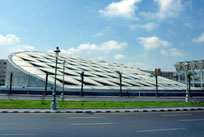 |
|
There is simply something very special with the name "Alexandria".
It creates images of a long and exciting history,
mixture of cultures, Africa meets the
Mediterranean Sea, and it is all true. Yet,
Alexandria tends to disappoint most of its
foreign visitors. It is like there is too little
evident of the history, and the fine examples of
ancient remains are not up to the expectations
most people. While the seafront is fabulous from a
distance, many ask themselves why there are not
more cafés and restaurants.
|
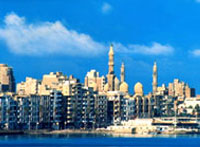 |
|
|
Keeping all that in mind, it is not difficult to have a fine
few days in this city. You just need to put some
effort into it, walk a little bit extra to find
what you need because it is all there.
Egyptian boats are generally very colorful,
most with an
individual pattern. it may be a combination of the
safety of being visible out on the sea.
and taking pride in one's boat. Some decorations are
created out of superstition, like warding oneself
against the evil eye. |
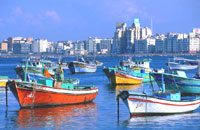 |
|
|
|
|
Alexandria
is unbelievably long. Most visitors walk the streets
and see the sea from the western area of Manshiya,
which also is the true city centre. However, east of
the new library, a new row of houses appear just as
long as the one of Manshiya. Moreover, it continues
beyond this too. If you have a lot of time, you
could walk the entire stretch, starting at Fort
Qaitbey and ending at Montazah.
The 20 or so kilometers should be done in 3-4 hours.
On the other hand, you could hire a taxi for the
ride, preferably going from Montazah, which allows
you to see the beach stretches.
I found it impressive, although not many of
the seafront houses looked as nice as they ought to.
However, the total is great, and the road undulates
along the cliffs and the several beaches. I thought
to myself that I had started to understand why
Egyptians are so crazy about this city.
Alexandria in late November (2004), It is
chilly, windy and the waves unfriendly. In addition, this is in April (1999). This is perhaps
the finest time of ten year for swimming, without
the loads of tourists filling Alexandria over
summer.swim, should you really
want. |
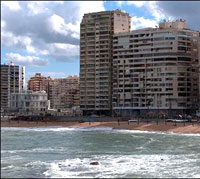
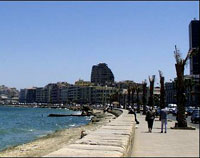 |
|
|
|
|
|
A
glance at Alexandria
More
than 2,000 years ago Alexandria was the capital and
the greatest city of Egypt. Today, though it has
been surpassed by Cairo in both size and importance,
Alexandria is Egypt's foremost seaport and its
second largest city. Roads, trains, and airlines
connect it with Cairo, 223 kilometers up the Nile
Delta to the southeast.
Miles of beautiful white sand along the
Mediterranean coast provide the setting for this
trading city and holiday resort. Summertime brings
crowds of people to the beaches that stretch to the
suburbs of Agami in the west and Abu Quir in the
east. Clear, calm waters make Abu Quir a popular
place for fishing and other water sports. Unlike
most Egyptian cities, Alexandria is sometimes chilly
and rainy in winter.
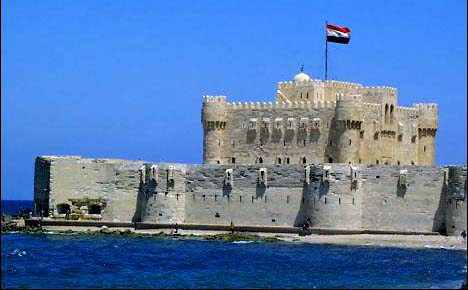 Education is compulsory for children aged 6 to 12.
Young people may continue through technical school
or university level free of charge. The
state-controlled University of Alexandria was
founded in 1942. Education is compulsory for children aged 6 to 12.
Young people may continue through technical school
or university level free of charge. The
state-controlled University of Alexandria was
founded in 1942.
Industries produce cotton textiles, paper,
chocolate, processed foods, asphalt, and petroleum.
Cotton is the most valuable export.
Lighthouse of Alexandria (Pharos Lighthouse)
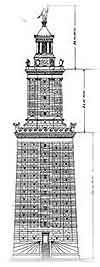 Of
the Seven Wonders of the Ancient World, only one had
a practical use in addition to its architectural
elegance: The Lighthouse of Alexandria. For sailors,
it ensured a safe return to the Great Harbor. For
architects, it meant even more: it was the tallest
building on Earth. And for scientists, it was the
mysterious mirror that fascinated them most.. The
mirror which reflection could be seen more than 50
km (35 miles) off-shore. Of
the Seven Wonders of the Ancient World, only one had
a practical use in addition to its architectural
elegance: The Lighthouse of Alexandria. For sailors,
it ensured a safe return to the Great Harbor. For
architects, it meant even more: it was the tallest
building on Earth. And for scientists, it was the
mysterious mirror that fascinated them most.. The
mirror which reflection could be seen more than 50
km (35 miles) off-shore.
Shortly after the death of Alexander the Great, his
commander Ptolemy Soter assumed power in Egypt. He
had witnessed the founding of Alexandria, and
established his capital there. Off of the city's
coast lies a small island: Pharos. Its name, legend
says, is a variation of Pharaoh's Island. The island
was connected to the mainland by means of a dike -
the Heptastadion - which gave the city a double
harbor. And because of dangerous sailing conditions
and flat coastline in the region, the construction
of a lighthouse was necessary.
The project was conceived and initiated by
Ptolemy Soter around 290 BC, but was completed after
his death, during the reign of his son Ptolemy
Philadelphus. Sostratus, a contemporary of Euclid,
was the architect, but detailed calculations for the
structure and its accessories were carried out at
the Alexandria Library/Mouseion. The monument was
dedicated to the Savior Gods: Ptolemy Soter (lit.
savior) and his wife Berenice. For centuries, the
Lighthouse of Alexandria (occasionally referred to
as the Pharos Lighthouse) was used to mark the
harbor, using fire at night and reflecting sun rays
during the day. It was even shown on Roman coins,
just as famous monuments are depicted on currency
today.
|
|
Beaches in Alexandria
In spite of miles of white sandy beaches and azure
sea, Egypt's Mediterranean is still undeveloped and
relatively unpopulated. There are fine beaches all
along the coast from Alex to Marsa Matrouh,
including the resort of Sidi Abd al Rahman, a
secluded bay with clear waters and a selection of
villas and hotels.
When the biting winter cold sets in, the shores of
Egypt, stretching unpolluted for miles and miles,
bask in the warmth of the sun that has deserted
other shores to shine only here honoring, it seems,
the ancient days when the sun was an Egyptian deity.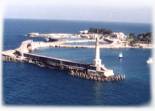
Despite the passage of the time, the sun still
remains friendly to Egypt, and invites you to enjoy
a winter warmth away from the bitter snowy cold, and
a pleasant summer breeze far from the oppressive
midday heat.
Egypt, a world renowned winter resort, has beautiful
and numerous beaches. Its northern coast from Sallum
to Rafah is 1181km, long; its eastern coastline,
from Suez to Halayeb, is some 1085 km long; while
the shores on the Gulfs of Suez and Aqaba teem with
the most exquisite beaches, spectacular coral reefs
and large varieties of colored fish, rarely found
elsewhere.
Anyone who has seen but a part, must return many
times, to feast his eyes and fill his heart with
these attractive images that will forever remain
stamped in his memory, as if one were viewing the
most exquisite paintings on earth.
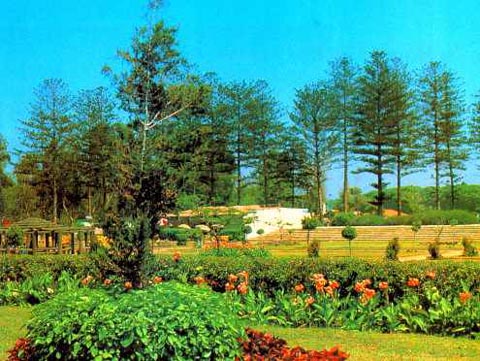 There
are many sandy beaches stretching from east to west
of Alexandria: Ma'amura - Muntazah - Mandara -
Assafra - Miami - Sidi Bishr - San Stefano -
Glymonopolou - Stanley - Rushdy - Sidi Gaber -
Sporting - Ibrahimia and Shatby, all of which lie
along the seafront boulevard, the Cornish. There
are many sandy beaches stretching from east to west
of Alexandria: Ma'amura - Muntazah - Mandara -
Assafra - Miami - Sidi Bishr - San Stefano -
Glymonopolou - Stanley - Rushdy - Sidi Gaber -
Sporting - Ibrahimia and Shatby, all of which lie
along the seafront boulevard, the Cornish.
On the western perimeter lie Agami and Hannoville.
Beaches in Alexandria in summer are crowded with
people escaping the hot weather to enjoy a good
swim. All summer holiday areas are provided with
tourist amenities, services and recreation
facilities and hotels. |
|
|
|
|
|
|
|
|
|